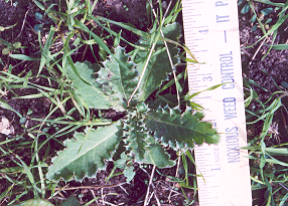Musk Thistle Control Program

Musk Thistle Control Program June 1, 2000
( This plant has a distinctive gray or silver edging to its leaves even at the seedling size)
DESCRIPTION
Musk thistle is primarily a biennial or winter annual but may occur as a summer annual. The leaves of musk thistle are deeply lobed, hairless, and are dark green with a light green mid-rib. The leaf base extends down the stem to give the plant a winged appearance. Musk thistle is the first of the Kansas thistles to bloom in the Spring. The terminal flower is large (1 ½ to 3 inches in diameter), solitary and usually nodding or bent over slightly. The plant is freely branched and each branch may have one flower or more in addition to the terminal flower. The flowers are purple and are “powder puff” shaped. Seed dispersal begins 7 to 10 days after blooming. Seeds are straw-colored, oblong, and 1/8 inch in length. The seeds are attached to parachute-like hairs (pappus) which allow for their dispersal by wind currents.
PREVENTION OF SPREAD OF MUSK THISTLE
Musk thistle may be found throughout the State with heaviest infestations found in the north eastern one third of the State. Musk thistle only reproduces by seed. The likelihood of new infest-ations will be reduced by any action to prevent the production and movement of seed. Planting weed free seed, feeding hay free of musk thistle seed and cleaning equipment before leaving infested areas are methods which will prevent the spread of musk thistle.
MUSK THISTLE CONTROL PRACTICES
The control of musk thistle shall mean preventing the production of viable seed.
CULTURAL CONTROL
Mowing - Mow with a rotary mower between the first appearance of pink and the appearance of brown on the pappus of the earliest heads. Mow cleanly and closely and repeat as needed for control.
Hand cutting - Digging - Cut between the first appearance of pink and the first appearance of brown on the pappus of the earliest head. Dig the root at least two inches below ground level and remove all the soil from the roots.
Pick heads that are beyond the bud stage and place in a tight container. Bury the container at a landfill or other site that will not be unearthed.
HERBICIDES APPROVED FOR CONTROLLING MUSK THISTLE
The following herbicides may be used for cost-share with landowners. Always read and follow label directions.
2,4-D Amine or LV Ester
Chlorsulfuron (Telar)
Dicamba (Banvel, Clarity, Vanquish)
Dicamba + 2,4-D
Picloram (Tordon)
Picloram + 2,4-D
Metsulfuron Methyl (Escort)
Metsulfuron Methyl + 2,4-D
Imazapic (Plateau)
Clopyralid + Triclopyr (Redeem R+P)
Triasulfuron + Dicamba (Rave)
Per acre costs for these chemicals can be obtained from the Marion County Weed Office at 620-382-3190 or emailing jhousman@marioncoks.net
BIOLOGICAL CONTROL PLAN
Any biological control plan must meet the requirements of K.A.R. 4-8-41.
